
Gymnopilus luteofolius, known as the yellow-gilled gymnopilus, is a large and widely distributed mushroom that grows in dense clusters on dead hardwoods and conifers. It grows in late July to November in the east and in the winter on the west coast of North America. It has a rusty orange spore print and a bitter taste.
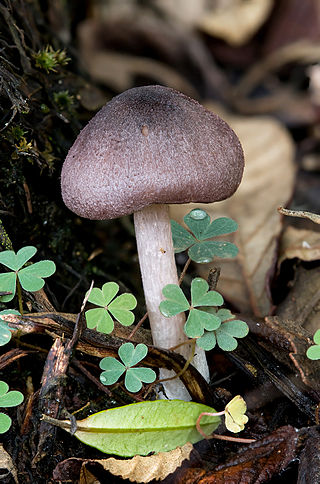
Entoloma austroprunicolor is a species of agaric fungus in the family Entolomataceae. Described as new to science in 2007, it is found in Tasmania, where it fruits on the ground of wet sclerophyll forests in late spring to early winter. The fruit bodies (mushrooms) have reddish-purple caps measuring up to 5 cm (2.0 in) in diameter supported by whitish stipes measuring 3–7.5 cm (1.2–3.0 in) long by 0.2–0.6 cm (0.1–0.2 in) thick. On the cap underside, the crowded gills are initially white before turning pink as the spores mature.
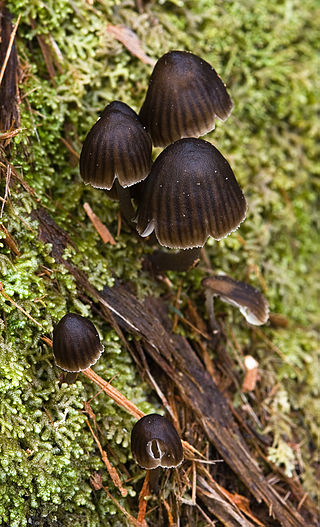
Mycena nargan, commonly known as the Nargan's bonnet, is a species of fungus in the family Mycenaceae, and the sole member of the section Nargan in the genus Mycena. Reported as a new species in 1995, it is known predominantly from Southern Australia. The saprobic fungus produces mushrooms that grow on well-decayed wood, often on the underside of wood lying in litter. The dark chestnut-coloured caps are covered with white, easily removed scales, and reach diameters of up to 2 cm (0.8 in) wide. The pale, slender stems are up to 5 cm (2.0 in) long and have white scales at the base. On the underside of the cap, the cream-coloured gills are widely spaced and bluntly attached to the stem. The edibility of the mushroom is unknown.
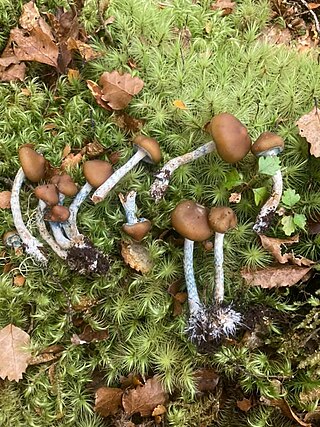
Psilocybe makarorae is a species of psilocybin mushroom in the family Hymenogastraceae. Officially described as new to science in 1995, it is known only from New Zealand, where it grows on rotting wood and twigs of southern beeches. The fruit body (mushroom) has a brownish cap with lighter coloured margins, measuring up to 3.5 cm (1.4 in) wide. The cap shape is either conical, bell-shaped, or flat depending on the age of the mushroom, and it features a prominent umbo. Although the whitish stem does not form a true ring, it retains remnants of the partial veil that covers and protects the gills of young fruit bodies. P. makarorae mushrooms can be distinguished from the similar North American species Psilocybe caerulipes by microscopic characteristics such as the presence of cystidia on the gill faces (pleurocystidia), and cheilocystidia with more elongated necks. Based on the bluing reaction to injury, P. makarorae is presumed to contain the psychedelic compounds psilocybin and psilocin.

Mycena clariviolacea is a mushroom in the family Mycenaceae. First reported as a new species in 2007, it is known only from Kanagawa, Japan, where it fruits on dead fallen twigs in forests dominated by oak and chinquapin trees. Distinctive features of this species are found in its medium-sized, dark violet fruit bodies, with caps up to 25 mm (0.98 in) in diameter and slender stems that are about 30 to 40 mm long. Microscopic characteristics include the amyloid spores, the club-shaped cheilocystidia that are covered with one or more, knob-like, apical protuberances, the absence of pleurocystidia, and the cylindrical, diverticulate caulocystidia.

Mycena fonticola is a species of fungus in the family Mycenaceae. First reported in 2007, it is known only from central Honshu, in Japan, where it grows on dead leaves and twigs in low-elevation forests dominated by oak trees. The fruit body of the fungus has a smooth, violet-brown cap up to 2.5 cm (1.0 in) in diameter, and a slender stem up to 10 cm (3.9 in) long. Distinguishing microscopic characteristics of the mushroom include the relatively large, distinctly amyloid spores, the smooth, spindle-shaped cheilocystidia, the absence of pleurocystidia, the diverticulate hyphae of the cap cuticle, and the absence of clamp connections.

Mycena lanuginosa is a species of mushroom in the family Mycenaceae. First collected in 2000 and reported as a new species in 2007, it is known only from lowland oak-dominated forests in central Honshu in Japan. The small mushroom is characterized by its grooved, grayish-brown to violet-brown cap up to 11 mm (0.43 in) in diameter, and the slender grayish-brown to reddish-brown stem covered with minute, fine, soft hairs. The mushroom produces amyloid spores. Microscopic distinguishing features include the smooth, spindle-shaped cheilocystidia and pleurocystidia and the diverticulate elements in the outer layer of the cap and the stem.

Mycena multiplicata is a species of mushroom in the family Mycenaceae. First described as a new species in 2007, the mushroom is known only from the prefecture of Kanagawa, Japan, where it grows on dead fallen twigs in lowland forests dominated by oak. The mushroom has a whitish cap that reaches up to 13 mm (0.51 in) in diameter atop a slender stem 15 to 20 mm long and 1 to 1.3 mm thick. On the underside of the cap are whitish, distantly spaced gills that are narrowly attached to the stem. Microscopic characteristics of the mushroom include the amyloid spores, the pear-shaped to broadly club-shaped cheilocystidia which are covered with a few to numerous, unevenly spaced, cylindrical protuberances, the lack of pleurocystidia, and the diverticulate hyphae in the outer layer of the cap and stem. The edibility of the mushroom is unknown.

Mycena mustea is a species of mushroom in the family Mycenaceae. First described as a new species in 2007, the fungus is known only from Kanagawa, Japan, where it grows on dead fallen twigs in lowland forests. The mushroom's dull violet to grayish-violet cap, initially covered with a fine whitish powder, becomes smooth as it matures, and eventually reaches a diameter of up to 10 mm (0.39 in). The stem is slender, up to 90 mm (3.5 in) long, and is covered with stiff white hairs at the base. Underneath the cap are distantly spaced pale brownish gills that are narrowly attached to the stem. Microscopic characteristics of the mushroom include the weakly amyloid spores, the club-shaped cheilocystidia featuring one or more short knob-like protuberances, the absence of pleurocystidia, the diverticulate cap cuticle hyphae, and the absence of clamp connections.

Mycena nidificata is a species of fungus in the family Mycenaceae of the Agaricales. First collected in 2000 and reported as a new species in 2007, it is known only from Kanagawa, Japan, where it grows on the floor of oak forests. The dark brown irregularly wrinkled cap measures up to 25 mm (1.0 in) in diameter. The cap is supported by a thin stem up to 50 mm (2.0 in) long, which is covered at the base by a whitish hairlike growth, and attached to white, cord-like rhizomorphs—aggregations of mycelium that resemble plant roots. The underside of the cap features thin, distantly spaced grayish gills that have distinct veins running between them. At a microscopic level, distinguishing characteristics include the inamyloid spores, the club-shaped cheilocystidia with finger-like appendages, the diverticulate cells in the outer layer of cap and stem, and the presence of clamp connections.

Pluteus nevadensis is a species of fungus in the agaric family Pluteaceae. Described as new to science in 2010, the species is known only from subtropical and pine forests in Mexico, where it grows on rotting pine and oak wood. Fruit bodies (mushrooms) have red-orange caps up to 3.8 cm (1.5 in) in diameter with a shape ranging from conic, convex, or flattened, depending on their age. The silky yellow stems are up to 4.5 cm (1.8 in) long. It is similar in appearance to Pluteus aurantiorugosus, with which it shares an orange- or scarlet-colored cap and a yellow stem. P. nevadensis can be distinguished from this and other superficially similar Pluteus species by differences in microscopic characteristics.

Lepiota anupama is a gilled mushroom of the genus Lepiota in the order Agaricales. Found in Kerala State, India, it was described as new to science in 2009.
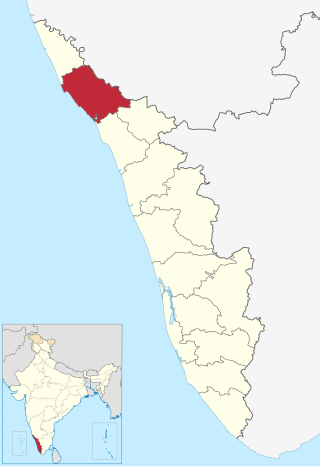
Lepiota babruka is a gilled mushroom of the genus Lepiota in the order Agaricales. Known only from Kerala State, India, it was described as new to science in 2009.

Lepiota babruzalka is an agaric mushroom of the genus Lepiota in the order Agaricales. Described as new to science in 2009, it is found in Kerala State, India, where it grows on the ground in litterfall around bamboo stems. Fruit bodies have caps that measure up to 1.3 cm (0.5 in) in diameter, and are covered with reddish-brown scales. The cap is supported by a long and slender stem up to 4.5 cm (1.8 in) long and 1.5 millimetres (0.1 in) thick. One of the distinguishing microscopic features of the species is the variably shaped cystidia found on the edges of the gills.

Lepiota nirupama is a species of agaric fungus of the genus Lepiota in the order Agaricales. Known only from Kerala State in India, it was described as new to science in 2009.

Lepiota shveta is an agaric fungus of the genus Lepiota in the order Agaricales. Described as new to science in 2009, it is found in Kerala State, India.
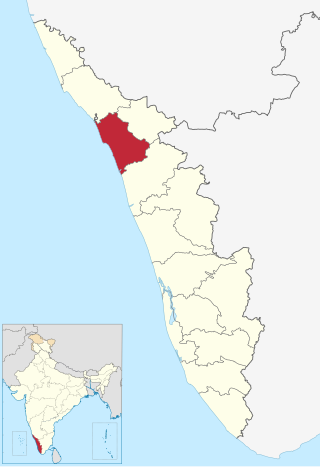
Lepiota zalkavritha is an agaric fungus of the genus Lepiota, order Agaricales. Described as new to science in 2009, it is found in Kerala State, India.

Lepiota ananya is a gilled mushroom of the genus Lepiota in the order Agaricales. Known only to come from Kerala State, India, it was described as new to science in 2009.

Lepiota castaneidisca is a species of agaric fungus in the family Agaricaceae. Formally described in 1912, it was for a long time considered the same species as the similar Lepiota cristata until molecular analysis reported in 2001 demonstrated that it was genetically distinct. It is most common in coastal and northern California, and has also been recorded in Mexico. A saprobic species, it is usually found under redwood and Monterey cypress. Its fruit bodies (mushrooms) have white caps with an orange-red to orange-brown center that measure up to 3.2 cm (1.3 in) wide. The cream-colored to light pink stems are up to 6.5 cm (2.6 in) long by 0.2–0.6 cm (0.1–0.2 in) thick, and have a ring. L. castaneidisca can be distinguished from other similar Lepiota species by differences in habitat, macroscopic, or microscopic characteristics.
Lepiota cristatanea is a species of agaric fungus in the family Agaricaceae. Described as new to science in 2011, it is found in China. The mushroom is similar to the widespread species Lepiota cristata but can be distinguished by its smaller spores.













